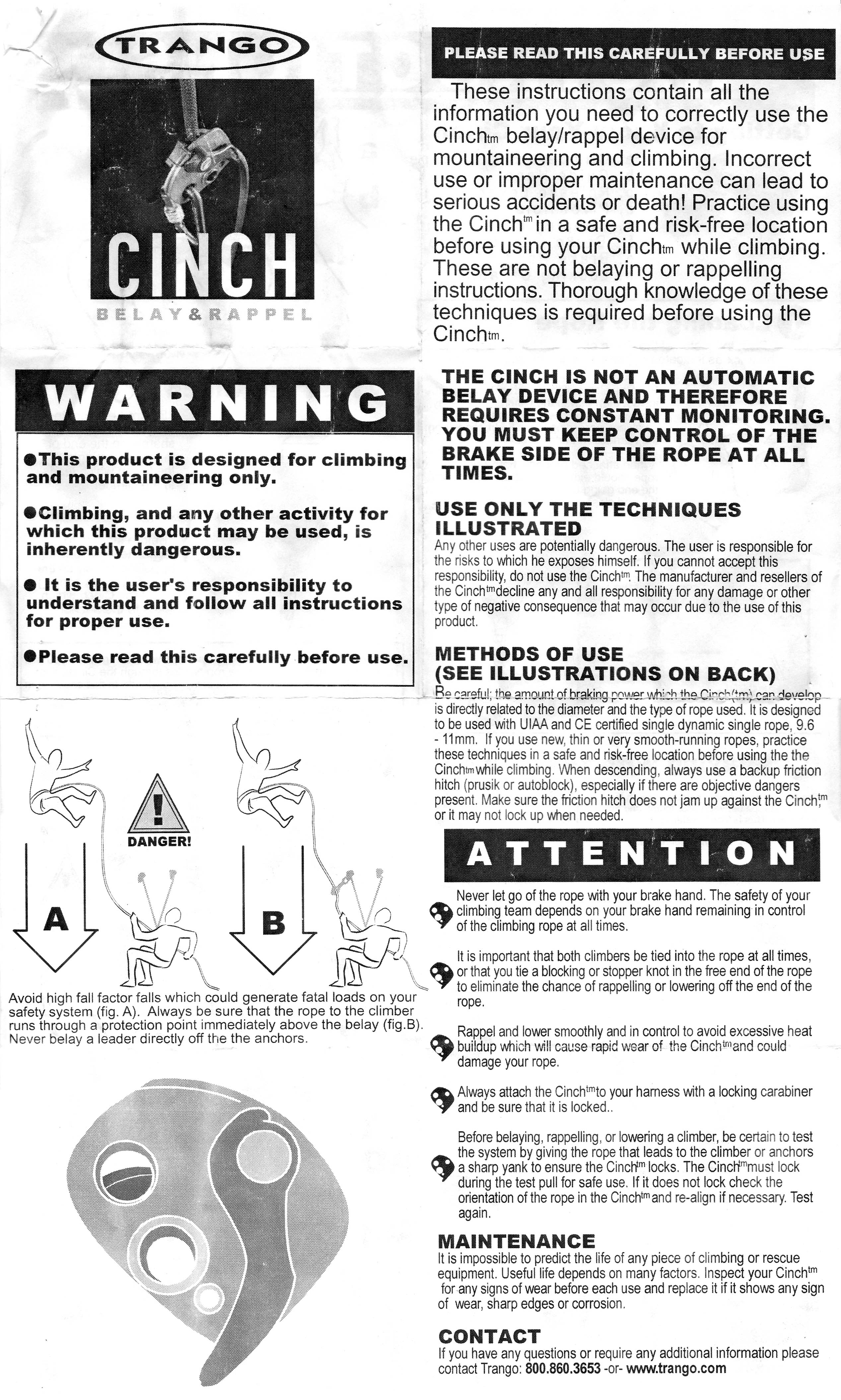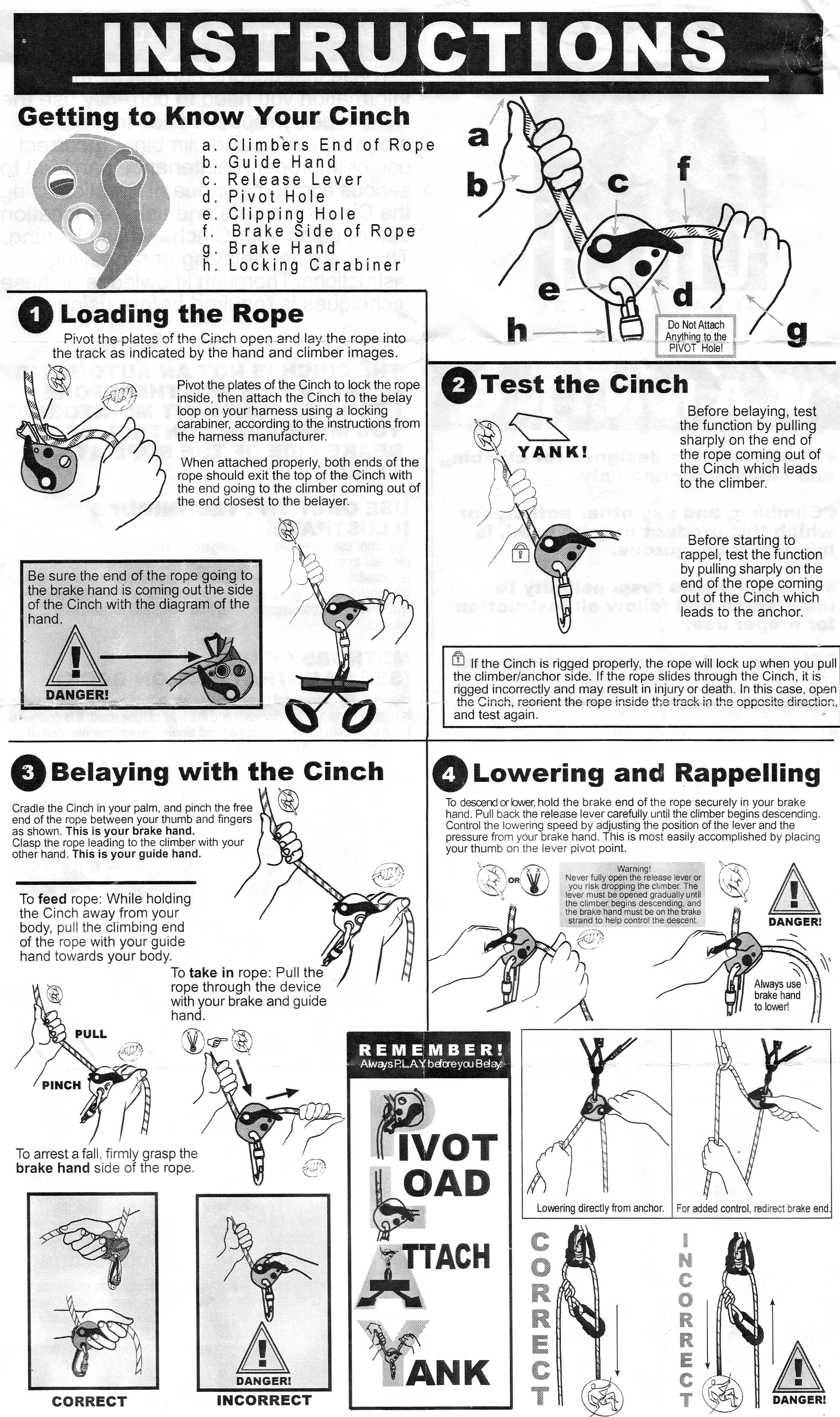Overview
[ Top
| Version B
| Return to Lever Box Belay
]
Version A
(#802)
Technical Details
I acquired my Cinch from Mountain Gear in 2004.
The Cinch consists of a cast steel back, milled aluminum front
cover, plastic handle, and miscellaneous parts. The back is irregular
in shape. The inside provides a rope channel with cast icons showing
which end of the rope goes to the climber and which is used for
belay. A tubular extension below the rope channel provides an
axle for the cover to rotate on. The outer end of this extension
is crimped over a steel washer to retain the cover. A hollow triangular
extension ends in a hooked lip that captures the cover when closed.
The back of the plate has several reinforcing ribs.
The cover is milled from aluminum, and then anodized. Most
of the cover is 6 mm. thick (except for a 2.7 mm. thick
area behind and above the lever, forming a lever stop, and the
hook engagement arc mentioned later), but the portion fitting
over the back axle is 18.5 mm. thick. A small extension to
this portion acts as a cam for stopping rope motion. An 8 mm
steel pin pressed into the front cover rests in a cylindrical
depression in the extension; this pin forms the part of the cam
that contacts the rope. This provides wear resistance beyond what
aluminum would provide. The left side of the cover is a circular
arc that fits into the notch in the back’s hook.
The cover has a rivet-mounted plastic lever on its left side.
A spring forces the lever clockwise to the closed position. To
use the lever, swing it counter-clockwise, where depressing the
lever will cause the hooked extension to ride in a molded cam
surface in the lever, forcing the cover to turn clockwise with
respect to the back, thereby releasing the cam pressure on the
rope. Although perhaps sounding strange, this isn't a typo: pushing
down on the lever moves the left side of the cover up.
The front of my Cinch is printed with an ellipse containing
"TRANGO," the word "CINCH," "USA,"
"1104," "M," the Reading
is Dangerous icon, "CHECK BEFORE EACH USE: rope to climber/anchor
must lock for proper function," "9.4-11 mm. rope,"
and "proper training required." The handle has "TRANGO" inside an ellipse. The inside of the back piece has a hand icon and a climber icon to indicate the rope path.
Comment
The Cinch is well made. It is a complex device that requires
more training and familiarization than most devices, much like
the Petzl Grigri. Like the
Grigri, the Cinch provides
an autolocking feature that may be useful on big walls where the
belayer is snoozing, but I’d rather have my second awake. At least
the Cinch is much smaller and lighter than the Grigri.
The lever action on the Cinch is cool: someone did some nice
thinking here, although some may find the lever action to be too
abrupt.
The hook ensures that the front cover does not spring away
from the back, although the normal rope loading does not tend
to force this.
I'm not a fan of autolocking belay devices, but I have to admit
that I haven't had as much experience with the Cinch as I would
like to have. Since I'm not likely to take such a large complex
device to the crag, a more detailed evaluation will have to wait
until I pay to visit a local climbing wall.
[ Top
| Version A
| Return to Lever Box Belay
]
Version B
(#1776, 2669)
Technical Details
I acquired my Trango Cinch, Version B from Unique Outfitters in2012.
Version B is 76 mm. tall, 77 mm. wide, 36 mm. thick, and weighs 187 g. The handle is longer than the one on Version A, and the front washer is smaller.
The front of my Cinch is printed with an ellipse containing
"TRANGO," the word "CINCH," "USA,"
"9674," the Reading
is Dangerous icon, "IMPORTANT!," "Expert use only," "Ø9.4 - 11mm," "Made in USA," "PAT#6,843,346," and "CE0123." The inside of the back piece has a hand icon and a climber icon to indicate the rope path. The handle has "TRANGO" inside an ellipse.
Comment
The differences between the two versions are minor and do not seem to affect functionality much.
[ Top
| Version A
| Version B
]




